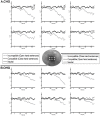Applauding with closed hands: neural signature of action-sentence compatibility effects
- PMID: 20676367
- PMCID: PMC2911376
- DOI: 10.1371/journal.pone.0011751
Applauding with closed hands: neural signature of action-sentence compatibility effects
Abstract
Background: Behavioral studies have provided evidence for an action-sentence compatibility effect (ACE) that suggests a coupling of motor mechanisms and action-sentence comprehension. When both processes are concurrent, the action sentence primes the actual movement, and simultaneously, the action affects comprehension. The aim of the present study was to investigate brain markers of bidirectional impact of language comprehension and motor processes.
Methodology/principal findings: Participants listened to sentences describing an action that involved an open hand, a closed hand, or no manual action. Each participant was asked to press a button to indicate his/her understanding of the sentence. Each participant was assigned a hand-shape, either closed or open, which had to be used to activate the button. There were two groups (depending on the assigned hand-shape) and three categories (compatible, incompatible and neutral) defined according to the compatibility between the response and the sentence. ACEs were found in both groups. Brain markers of semantic processing exhibited an N400-like component around the Cz electrode position. This component distinguishes between compatible and incompatible, with a greater negative deflection for incompatible. Motor response elicited a motor potential (MP) and a re-afferent potential (RAP), which are both enhanced in the compatible condition.
Conclusions/significance: The present findings provide the first ACE cortical measurements of semantic processing and the motor response. N400-like effects suggest that incompatibility with motor processes interferes in sentence comprehension in a semantic fashion. Modulation of motor potentials (MP and RAP) revealed a multimodal semantic facilitation of the motor response. Both results provide neural evidence of an action-sentence bidirectional relationship. Our results suggest that ACE is not an epiphenomenal post-sentence comprehension process. In contrast, motor-language integration occurring during the verb onset supports a genuine and ongoing brain motor-language interaction.
Conflict of interest statement
Figures




Similar articles
-
Motor-language coupling: direct evidence from early Parkinson's disease and intracranial cortical recordings.Cortex. 2013 Apr;49(4):968-84. doi: 10.1016/j.cortex.2012.02.014. Epub 2012 Mar 8. Cortex. 2013. PMID: 22482695
-
Interplay between syntax and semantics during sentence comprehension: ERP effects of combining syntactic and semantic violations.J Cogn Neurosci. 2003 Aug 15;15(6):883-99. doi: 10.1162/089892903322370807. J Cogn Neurosci. 2003. PMID: 14511541
-
Semantic integration processes at different levels of syntactic hierarchy during sentence comprehension: an ERP study.Neuropsychologia. 2010 May;48(6):1551-62. doi: 10.1016/j.neuropsychologia.2010.02.001. Epub 2010 Feb 6. Neuropsychologia. 2010. PMID: 20138898
-
Getting real about semantic illusions: rethinking the functional role of the P600 in language comprehension.Brain Res. 2012 Mar 29;1446:127-43. doi: 10.1016/j.brainres.2012.01.055. Epub 2012 Feb 2. Brain Res. 2012. PMID: 22361114 Review.
-
Neural mechanisms of language comprehension: challenges to syntax.Brain Res. 2007 May 18;1146:23-49. doi: 10.1016/j.brainres.2006.12.063. Epub 2006 Dec 23. Brain Res. 2007. PMID: 17400197 Review.
Cited by
-
N400 ERPs for actions: building meaning in context.Front Hum Neurosci. 2013 Mar 4;7:57. doi: 10.3389/fnhum.2013.00057. eCollection 2013. Front Hum Neurosci. 2013. PMID: 23459873 Free PMC article.
-
The Bilingual Lexicon, Back and Forth: Electrophysiological Signatures of Translation Asymmetry.Neuroscience. 2022 Jan 15;481:134-143. doi: 10.1016/j.neuroscience.2021.11.046. Epub 2021 Dec 2. Neuroscience. 2022. PMID: 34864107 Free PMC article.
-
Motor-system dynamics during naturalistic reading of action narratives in first and second language.Neuroimage. 2020 Aug 1;216:116820. doi: 10.1016/j.neuroimage.2020.116820. Epub 2020 Apr 8. Neuroimage. 2020. PMID: 32278096 Free PMC article.
-
Two-person neuroscience and naturalistic social communication: the role of language and linguistic variables in brain-coupling research.Front Psychiatry. 2014 Sep 5;5:124. doi: 10.3389/fpsyt.2014.00124. eCollection 2014. Front Psychiatry. 2014. PMID: 25249986 Free PMC article. Review.
-
Embodiment Effect on the Comprehension of Mandarin Manual Action Language: An ERP Study.J Psycholinguist Res. 2019 Jun;48(3):713-728. doi: 10.1007/s10936-018-09627-6. J Psycholinguist Res. 2019. PMID: 30656462
References
-
- Fischer MH, Zwaan RA. Embodied language: a review of the role of the motor system in language comprehension. Quart J Exp Psychol. 2008;825:850. - PubMed
-
- Pulvermuller F. Grounding language in the brain. In: de Vega M, Graesser A, Glenberg AM, editors. Symbols, embodiment, and meaning. Oxford: Oxford University Press; 2008. pp. 85–116.
-
- Warrington EK, Shallice T. Category specific semantic impairments. Brain. 1984;107 (Pt 3):829–854. - PubMed
-
- McCarthy R, Warrington EK. The dissolution of semantics. Nature. 1990;343:599. - PubMed
Publication types
MeSH terms
LinkOut - more resources
Full Text Sources
Miscellaneous

